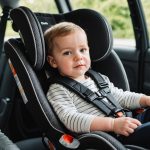Navigating the New UK Car Seat Regulations: What Parents with Infants Need to Know for Safe Travel
As a parent, ensuring the safety of your child, especially when traveling by car, is of utmost importance. The UK has implemented strict car seat regulations to protect children on the road, and it’s crucial to understand these rules to make sure your little ones are safe and secure. Here’s a comprehensive guide to help you navigate the new UK car seat regulations.
Understanding the Basics of Car Seat Safety
Before diving into the specifics of the regulations, it’s essential to grasp why car seats are so critical. Car seats are designed to reduce the risk of injury or death in the event of a car accident. Here are some key points to consider:
Also to discover : Essential Guide to Selecting the Perfect Cargo Van for Your UK Business Requirements
-
Why Car Seats are Essential: Car seats are engineered to fit the size and weight of your child, providing the necessary support and protection. For example, a rear-facing car seat is designed to cradle the head, neck, and spine of an infant in the event of a crash, significantly reducing the risk of serious injury[4].
-
Types of Car Seats: There are several types of car seats, each suitable for different ages and sizes of children. These include rear-facing seats, forward-facing seats, and booster seats. Each type has its own set of regulations and guidelines.
In the same genre : The Ultimate Guide to Selecting the Perfect Car Insurance for Young Drivers in the UK
UK Car Seat Regulations: A Detailed Guide
The UK car seat regulations are based on the child’s weight and height rather than their age. Here’s a breakdown of what you need to know:
Rear-Facing Car Seats
- For Infants and Young Children: Rear-facing car seats are recommended for children from birth until they are at least 15 months old or weigh up to 13 kg (29 lbs). These seats must be installed in the rear of the car and face the back of the vehicle.
- Example: The Axkid Minikid is a popular rear-facing seat that can be used from birth to approximately 4 years old, depending on the child’s weight and height[4].
Forward-Facing Car Seats
- For Older Children: Once your child outgrows the rear-facing seat, you can transition to a forward-facing seat. These seats are suitable for children who weigh between 9 kg (20 lbs) and 36 kg (79 lbs).
- Example: The Maxi-Cosi Tobi is a forward-facing seat that can be used from around 9 kg to 36 kg, providing a secure fit with its adjustable harness and impact-absorbing materials[4].
Booster Seats
- For Bigger Kids: Booster seats are designed for children who have outgrown their forward-facing seats but are still too small to use the car’s seat belt alone. These seats are typically used for children weighing between 15 kg (33 lbs) and 36 kg (79 lbs).
- Example: The Britax-Römer KidFix II is a popular booster seat that can be used in both high-back and backless modes, ensuring your child is safe and comfortable as they grow[4].
Key Regulations and Guidelines
Here are some critical regulations and guidelines to keep in mind:
Weight and Height Limits
- Rear-Facing Seats: Must be used until the child is at least 15 months old or weighs up to 13 kg (29 lbs).
- Forward-Facing Seats: Suitable for children weighing between 9 kg (20 lbs) and 36 kg (79 lbs).
- Booster Seats: Used for children weighing between 15 kg (33 lbs) and 36 kg (79 lbs).
Installation and Use
-
Correct Installation: Ensure the car seat is installed correctly according to the manufacturer’s instructions. Many car seats come with ISOFIX mounting points for easier and more secure installation.
-
Tip: Always refer to the car seat’s manual and your vehicle’s manual for specific installation instructions.
-
Harness and Belt Use: Make sure the harness or seat belt is fitted correctly. For rear-facing seats, the harness should be at or below the child’s shoulders. For forward-facing seats, it should be at or above the shoulders.
-
Quote: “The harness should be snug and not twisted. The chest clip should be at the child’s armpit level,” advises a safety expert from the Royal Society for the Prevention of Accidents (ROSPA).
Seat Laws and Penalties
- Legal Requirements: In the UK, it is illegal to carry a child in a car without a suitable child restraint. The penalty for non-compliance can include a fine of up to £500.
- Example: If you are caught driving with a child who is not properly restrained, you could face a significant fine and even penalty points on your license.
Choosing the Right Car Seat
With so many car seats on the market, choosing the right one can be overwhelming. Here are some tips to help you make an informed decision:
Consider Your Child’s Size and Age
- Weight and Height: Always check the weight and height limits of the car seat to ensure it is suitable for your child.
- Table: Car Seat Types and Weight Limits
Car Seat Type Weight Limit Age Range Rear-Facing Up to 13 kg (29 lbs) Birth to 15 months Forward-Facing 9 kg to 36 kg (20-79 lbs) 1 to 4 years Booster Seat 15 kg to 36 kg (33-79 lbs) 4 to 12 years Check for Safety Features
- Impact Protection: Look for car seats with advanced impact protection features such as side impact protection and energy-absorbing materials.
- Example: The Nuna Rava car seat features a steel frame and energy-absorbing foam for enhanced safety[4].
Read Reviews and Check Ratings
- Consumer Feedback: Read reviews from other parents to get a sense of the car seat’s performance and any potential issues.
- Quote: “We chose the Axkid Minikid based on the excellent reviews and its ability to be used for an extended period,” says Sarah, a mother of two.
Practical Tips for Safe Travel
Here are some practical tips to ensure safe travel with your child:
Regular Checks
- Seat Condition: Regularly check the car seat for any signs of wear or damage. Ensure all parts are securely attached and the harness is not frayed.
- Tip: Always follow the manufacturer’s guidelines for maintenance and replacement.
Correct Use
- Harness Adjustment: Make sure the harness is adjusted correctly each time you use the car seat. The harness should be snug but not too tight.
- Example: If your child is using a forward-facing seat, the harness should be at or above their shoulders.
Traveling with Older Children
- Transitioning to Booster Seats: When your child outgrows their forward-facing seat, transition them to a booster seat. Ensure the booster seat is used correctly, with the seat belt crossing the child’s body as it would for an adult.
- Quote: “Using a booster seat until your child is tall enough to use the car’s seat belt alone is crucial for their safety,” advises a road safety expert.
Common Mistakes to Avoid
Here are some common mistakes parents make when using car seats and how to avoid them:
Incorrect Installation
- ISOFIX vs. Seat Belt: Ensure you are using the correct installation method. ISOFIX seats are generally easier to install correctly, but seat belt installations can be just as secure if done right.
- Tip: Always refer to the car seat’s manual and your vehicle’s manual for specific installation instructions.
Incompatible Car Seats
- Vehicle Compatibility: Not all car seats are compatible with all vehicles. Make sure the car seat you choose is compatible with your car.
- Example: Some cars have specific ISOFIX points that may not be compatible with all ISOFIX car seats.
Outgrown Seats
- Weight and Height Limits: Ensure your child has not outgrown the car seat. Using a car seat that is too small can be just as dangerous as using one that is too large.
- Tip: Regularly check the weight and height limits of the car seat against your child’s growth.
Navigating the UK car seat regulations can seem daunting, but with the right information, you can ensure your child’s safety on the road. Remember to choose a car seat that fits your child’s size and age, install it correctly, and use it consistently. Here are some final tips to keep in mind:
- Always Follow Manufacturer Guidelines: The manufacturer’s instructions are there to ensure the car seat is used correctly.
- Regularly Check the Car Seat: Ensure the car seat is in good condition and adjusted correctly each time it is used.
- Stay Informed: Keep up-to-date with any changes in car seat regulations and safety standards.
By following these guidelines and tips, you can make sure your child is safe and secure every time you travel by car.
Additional Resources
For more detailed information and resources, you can refer to the following:
- Royal Society for the Prevention of Accidents (ROSPA): Provides comprehensive guides on car seat safety and installation.
- UK Government Guidelines: Offers detailed information on car seat regulations and laws.
- Manufacturer Websites: Many car seat manufacturers provide detailed manuals, installation guides, and safety tips on their websites.
By being informed and proactive, you can ensure your child’s safety on the road, giving you peace of mind every time you travel.
Types of Car Seats and Their Compliance
When considering car seat types, it’s essential to understand the different categories available, such as infant car seats, convertible car seats, and booster seats. Each of these categories is designed to meet specific safety and compliance requirements tailored to the child’s age, weight, and height.
Infant car seats are specifically designed for newborns and younger babies. They are rear-facing car seats, which is a critical safety feature for protecting infants during collisions. Compliance for infant car seats includes stringent guidelines to ensure they provide maximum support for the baby’s head, neck, and spine.
Convertible car seats grow with your child. Initially, they are used in a rear-facing position for infants, but they can be adjusted to a forward-facing position as your child grows. This dual functionality makes them a versatile and cost-effective option.
Booster seats are for older children who have outgrown their convertible car seats. They elevate the child so that the vehicle’s seatbelt fits properly over their chest and lap. Compliance requirements focus on ensuring that booster seats provide adequate support and positioning for safe seatbelt use.
When selecting a car seat, always consider your child’s age, size, and the specific compliance requirements for each car seat type to ensure their safety.











